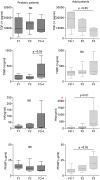The role of serum biomarkers in predicting fibrosis progression in pediatric and adult hepatitis C virus chronic infection
- PMID: 21858035
- PMCID: PMC3157356
- DOI: 10.1371/journal.pone.0023218
The role of serum biomarkers in predicting fibrosis progression in pediatric and adult hepatitis C virus chronic infection
Abstract
Background/aims: Liver biopsy represents the gold standard for damage evaluation, but noninvasive serum markers that mirror liver fibrosis progression are actual goals both in adults and especially in children. The aim was to determine specific serum markers that correlate with liver fibrosis progression during chronic HCV infection.
Methods: Liver biopsies and concomitant serum samples from 22 pediatric and 22 adult HCV patients were analyzed. Histological parameters were evaluated. On serum TGF-ß1, tissue inhibitor of matrix metalloprotein inhibitor-1 (TIMP-1), hyaluronic acid (HA) and aminoterminal peptide of procollagen type III (PIIINP) were tested.
Results: Significant fibrosis (F≥2) and advanced fibrosis (F≥3) represented 64% and 20%, respectively in children; while 54% F≥2 and 23% F≥3 in adults. Hyaluronic acid (p = 0.011) and PIIINP (p = 0.016) were related to worse fibrosis stages only in adults, along with TIMP-1 (p = 0.039) just in children; but TGF-ß1 was associated with mild fibrosis (p = 0.022) in adults. The AUROC of TIMP-1 in children to discriminate advanced fibrosis was 0.800 (95%IC 0.598-0.932). In adults, the best AUROCs were that of HA, PIIINP and TGF-ß1 [0.929 (IC95% 0.736-0.994), 0.894 (IC95% 0.689-0.984) and 0.835 (IC95% 0.617-0.957)], respectively. In children, according to the cut off (165.7 ng/mL) value for TIMP-1, biopsies could have been avoided in 72% (18/25). Considering the cut off for HA (109.7 ng/mL), PIIINP (9.1 µg/L), and TGF-ß1 (10,848.3 pg/mL), biopsies could have been avoided in 87% (19/22) of adult patients by using HA and 73% (16/22) using PIIINP or TGF-ß1.
Conclusions: In adults given the diagnostic accuracy of HA, PIIINP, TGF-ß1, their combination may provide a potential useful tool to assess liver fibrosis. This first pediatric study suggests that TIMP-1 is clinically useful for predicting liver fibrosis in HCV patients.
Conflict of interest statement
Figures


References
-
- Murray K, Finn L, Taylor S, Seidel K, Larson A. Liver histology and alanine aminotransferase levels in children and adults with chronic hepatitis C infection. J Pediatr Gastroenterol Nutr. 2005;41:634–638. - PubMed
-
- Kage M, Fujisawa T, Shiraki K, Tanaka T, Fujisawa T, et al. Pathology of chronic hepatitis C in children. Child Liver Study Group of Japan. Hepatology. 1997;26:771–775. - PubMed
-
- Badizadegan K, Jonas M, Ott M, Nelson S, Perez-Atayde A. Histopathology of the liver in children with chronic hepatitis C viral infection. Hepatology. 1998;28:1416–1423. - PubMed
-
- Jara P, Resti M, Hierro L, Giacchino R, Barbera C, et al. Chronic hepatitis C virus infection in childhood: clinical patterns and evolution in 224 white children. Clin Infect Dis. 2003;36:275–280. - PubMed
Publication types
MeSH terms
Substances
LinkOut - more resources
Full Text Sources
Medical
Research Materials
Miscellaneous

